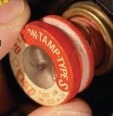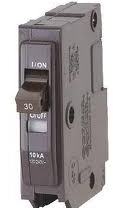
Electrical Dangers at Home
Breakers or Fuses that Frequently Blow
Everything electrical in your home has an over current protector / shutoff at the main service panel, in older home it came in the form of fuses, in newer home or homes that have been updated it comes in the form of resettable breakers.


Protective devices to cut the power off such as fuses and breakers are designed to be the weakest link in the system, it will stop current flow to the circuit and hopefully prevent damage / injuries and fire.
Be sure to also read the article ‘Changing the fuse or breaker to accommodate higher circuit loads’
To change a blown fuse is just a matter of screwing out the old and screwing in the new.
A breaker is reset by fully pushing the breaker switch to off and then back on.
Why does a fuse or breaker blow?
These are over current devices, when you exceed the circuit rating, the fuse or breaker will do its designed job and shut off the power to the circuit that exceeded its max rating. Circuits that frequently blow the over current protection device means too much current is being drawn, never ever install a higher rated fuse / breaker on a circuit with wiring and outlets rated at a lower max., read more at ‘Changing the fuse or breaker to accommodate higher circuit loads’
There are what is referred to as slow blow fuses that have the correct protection for the circuit wiring but do not blow as quickly when a mild over current condition exists for a brief period of time and these may be used for motorized items that give a very brief power surge at start up but run well within the circuit limits while running. My concern here is that slow blow means it takes a longer sustained period of an over current condition before the circuit power is shut down, even a brief delay could become the spark that could ignite a fire this is particularly a concern when underrated extensions are used, already worn electrical devices are in use, old wiring and so on. If need be have a new circuit wired into the home.
Instead take an inventory of everything on that circuit, remove some items from that circuit to reduce the load bellow the circuit rating. Some items with motors in them create a current surge at start up and then drop during normal running, older items that used to not be a problem may now be the cause of going over budget on current draw, wearing of bearing, winding in motors starting to burn out in spots of the winding may change the current draw even before they break down or short completely, for a motorized device that once was not a problem but now is, I would recommend replacing.
If you have an older home be sure to read the article on ‘Old Homes / Wiring’
WHILE EXTREME CARE HAS BEEN IMPLEMENTED IN THE PREPARATION OF THIS SELF-HELP DOCUMENT, THE AUTHOR AND/OR PROVIDERS OF THIS DOCUMENT ASSUMES NO RESPONSIBILITY FOR ERRORS OR OMISSIONS, NOR IS ANY LIABILITY ASSUMED FROM THE USE OF THE INFORMATION, CONTAINED IN THIS DOCUMENT, BY THE AUTHOR and / OR PROVIDER.
By: Donald Kerr